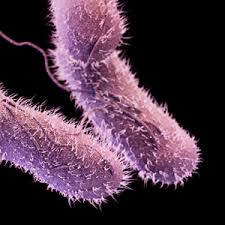Salmonella Dublin – A Risk To The Beef Herd
5 April 2017 Salmonella Dublin is a bacterium which more often causes disease in dairy herds than beef herds. However, buying in calves to twin on or rear, or buying beef x dairy replacement heifers can all be sources of risk to the beef herd.
Salmonella Dublin is a bacterium which more often causes disease in dairy herds than beef herds. However, buying in calves to twin on or rear, or buying beef x dairy replacement heifers can all be sources of risk to the beef herd.
Symptoms
Salmonella Dublin has very varied signs in cattle. In adult cattle it can cause diarrhoea, abortion or septicaemia. Sometimes the only signs seen are a high temperature, malaise and/or weight loss, and so it is not always dramatic. In calves it can cause diarrhoea, pneumonia, joint ill, septicaemia, nervous signs such as fitting, and loss of the eartips and hooves. Again it can also cause ill-thrift or poor growth rates. It is important to recognise that it can be seen in any one of these ways, and should be considered in any scenario where disease and death rates are high, or where growth rates are disappointing.
In dairy herds, the routes of spread and necessary preventative measures are quite well-established, and rely on closing routes of spread of the organism within the herd. It is important to note that once infected, some animals do not clear the infection, and become carriers. This means that infection can be long-lasting in a herd, although it is possible to control it.
How It Is Introduced
Salmonella Dublin is usually introduced into a herd by buying in carrier animals, although people can also introduce the bacteria, if they do not adequately clean and disinfect themselves between farms. The cost of introducing infection into a herd is not inconsiderable, and so beef herds buying animals from the dairy herd should think about ways to reduce this. If buying in replacement heifers, blood testing can be used to check for antibodies produced in response to the bacteria. While, negative results mean that the animals are unlikely to be infected, positive results can occur if an animal has encountered the bacteria, but is not necessarily currently infected. Positive results can also occur if animals have been vaccinated, and so it is worth checking if this is the case.
It is more difficult to assess whether bought in calves are infected, as calves of less than three months of age will have antibodies acquired from colostrum. Sourcing calves from herds with no known history of Salmonella Dublin infection, and with good calf health will reduce this risk. Minimising the number of farms calves are sourced from will also reduce the risk of introducing Salmonella Dublin.
Katrina Henderson, katrina.henderson@sac.co.uk
Sign up to the FAS newsletter
Receive updates on news, events and publications from Scotland’s Farm Advisory Service
